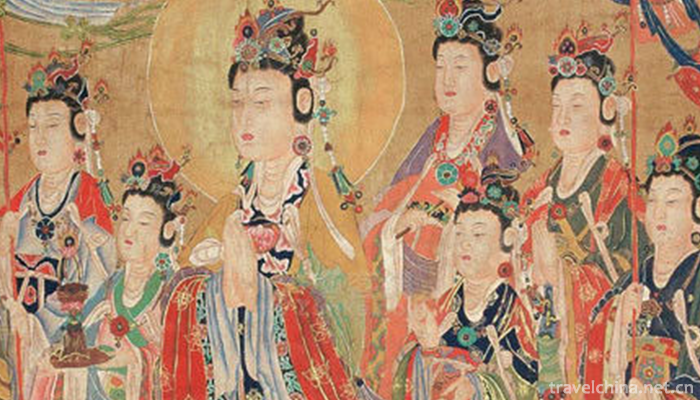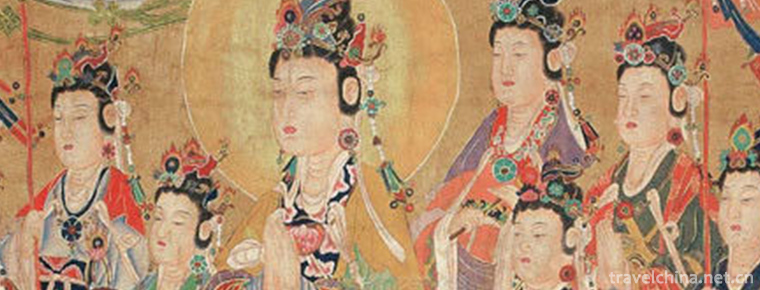Surface painting
Surface painting
Water and land painting Festival is a traditional religious painting. Originated in the Three Kingdoms Period, Buddhist monasteries prevailing from the Jin Dynasty to the Yuan, Ming and Qing Dynasties are an important Buddhist event held for the purpose of overtaking the dead and popularizing all the ghosts and gods on land and water. It is a folk cultural phenomenon that emerges and develops under the background of "the unity of the three religions". Land and water painting is a religious figure painting worshipped by the Land and Water Law Society.
On November 11, 2014, land and water paintings were approved by the State Council and listed in the fourth batch of national intangible cultural heritage list.
Historical Origin
Land and water law clubs, also known as "land and water fairs", "water and land fasts", "charity clubs" horse "charity clubs" and "seven fasts", are abbreviated as "land and water clubs", commonly known as "land and water clubs". They are all called "Saint Fan Shui Lu Pudu Ramadan Winning Club". They refer to the gathering of rescuers and rescued persons in the opening of law clubs. All participants can receive both excessive application of law and food and universal acceptance. Bitterness is a kind of grand law meeting which sets up a fasting to worship Buddha and gods to recommend the spirits and ghosts beyond the dead. It is the most solemn, grandest and longest ritual in Chinese religious activities. Waterfront painting emerged with the emergence of the Land and Water Law Society. It is a religious painting hanging in monasteries or private holding of the Land and Water Law Society. It is one of the indispensable sacred objects for holding the Land and Water Law Society. There is a cloud in a model vow of the Mid-Tang Dynasty unearthed from Tibetan ketone in Dunhuang at the end of Qing Dynasty: "So on this day, the courtyards were swept and the pavilions were strictly decorated. Buddhist monks were invited to set up their fasts to pursue their blessings..." At that time, on the "Dao Chang", there were various Buddhist banner wallcharts with religious figures as the theme, that is, the early land and water paintings. According to the existing literature, the early images of the Water and Land Law Society began in the late Tang and Five Dynasties, and gradually formed a system. Legend has it that the Southern Water and Land Society of Pingyang City, Shanxi Province, was named after 120 water and land painting axes of Wu Daozi (685-758) in the Tang Dynasty. Volume 23 of The Idol Talk in Chibei also has relevant records. Although this set of water and land paintings is the so-called works of Wu Daozi in the Tang Dynasty, in fact, it is not based on legends.
Through the spread and development of the Five Dynasties and the Song Dynasty, land and water painting has gradually formed into a complete set of scale. At that time, there were water and land halls and a complete set of water and land painting scrolls in Buddhist temples and Taoist concepts. For example, the main hall of Yanshan Temple in Fanshi Jin Dynasty in Shanxi Province was originally the water and land hall. The murals in the hall were painted by Wang Kui and Wang Dao in the third year of Zhenglong (1158). Unfortunately, the murals in the hall have been destroyed. During the Yuan and Ming Dynasties, the water and land paintings hanging on the waterway and land course were basically stereotyped. One hundred and twenty water and land paintings were painted in the West Water and Land Law Society built by the general monastery. As many as 200 axes of land and water paintings were used in the land and Water Law Societies built by the imperial court. These works are mostly painted by the masters of folk Taoist interpretation. They are precise and well-organized. Their contents include all the gods worshipped by the people. Their hanging lengths depend on the scale of the events. In addition, in this period, besides the complete set of scroll water and land portraits, special water and land halls appeared in Buddhist temples and Taoist concepts, and water and land frescoes with complete composition were painted.
Most of the land and water paintings preserved in the 21st century were painted in the Ming and Qing dynasties, especially in the temples of Shanxi and Hebei provinces. Although these temples were built in different times, most of them were painted after the Song and Yuan dynasties. Most of the existing water and land paintings in Shanxi are Ming Dynasty works. For example, the waist hall murals of Jishan Qinglong Temple (Shuilu Hall) are well preserved. Based on the investigation of architecture, murals style and relevant years, the murals of the whole hall should be completed in the early Ming Dynasty. The four-wall paintings of the temple used to depict immortals and ghosts, emperors and concubines, as well as Yincao prefecture, which advocated "retribution for cause and effect", suggesting that people should convert to religion to avoid suffering. The Ming murals of Dinglin Temple, Hunyuan Yongan Temple and Lingshi Zishou Temple in southern Shanxi also had merits of water and land. They were magnificent and full of figures, and were important works for studying the content and art of water and land paintings.
Inheritance Significance
Water and land paintings provide information for the study of Buddhist history. From its origin to its prosperity, land and water law societies have infiltrated many contents of Taoism, Confucianism and folk gods, from which we can learn the course of the Sinicization of Buddhism. In the early days of the founding of the People's Republic since the Tang and Song Dynasties, when the emperors ascended the throne, they built land and water law societies to recommend the dead of loyal ministers, martyrs and refugees, in order to appease the people's hearts and pray for social peace; and land and water paintings are also a historical study of the integration of Confucia Provide information. After Sui, Tang and Yuan dynasties, Confucianism, Buddhism and Taoism merged, but we mostly studied them from abstract literary materials. Water and land paintings provided us with very specific image data, from which we can see that the three religions of Confucianism, Buddhism and Taoism, gods, Buddha and immortals, organized in a mythological system in an orderly manner according to their levels and functions, are neither contradictory nor reasonable. Faith folklore research provides information. Buddha, gods and immortals in land and water paintings are worshipped by the Chinese people. From land and water paintings, we can study the Chinese people's belief in folk customs and belief psychology. Ming Dynasty's land and water paintings are more standardized and secular. In the paintings, not only the skills of cheap team paintings and landscape paintings, but also the contents of many folk customs can be seen. The pictures include social customs, which provide vivid and intuitive image data for modern people to study history; water and land paintings provide information for the study of ancient Chinese costumes; water and land paintings describe the style and color of the costumes of the characters at that time in detail. In addition to the portraits of Buddha, gods and immortals, painters in ancient times depicted them according to pink books. The common costumes of ancient sages and sages were painted according to the costume system of the society at that time, which provided specific images for the study of costumes in ancient China. The costumes in modern Chinese drama are very similar to those in land and water paintings, and also can provide information for the study of the history of Chinese drama.
Master of Water and Land Painting
With the development of waterway and land painting, waterway and land painting has become a kind of Chinese religious painting. The founder of Buddhist painting is said to be Cao Fuxing, a famous painter in the Three Kingdoms Period. Later, many famous painters painted murals of various religious villages for monasteries. Gu Kaizhi, a famous artist in the Eastern Jin Dynasty, is not only good at drawing characters. Landscape, and the religious paintings are also outstanding in the painting world. There is a well-known story about the Vimo portrait he painted for the Wacoffin Temple in Luoyang. According to legend, he tried painting for a month behind closed doors, and opened an account for people to appreciate. The image of Vimo theory is clear and elegant. The image of "Lighting One Temple" and even "the giver bites the throat" instantly "makes the bait millions".


-
1.Canton Tower
Located in Guangzhou Haizhu District (Yizhou Island) near the Chigang Tower,
Time 2018-10-12 -
3.Duck blood soup with vermicelli
Duck blood vermicelli soup is a famous specialty in Nanjing, belonging to Jinling food...
Time 2018-10-26 -
4.Mandarin Oriental Hotel Guangzhou
Wenhua Oriental Hotel is located in Tianhe District of Guangzhou, which belongs to Wenhua Oriental Hotel Group. It is a five-star hotel. The hotel has 233 rooms and 30 suites, and 24 hotel-style servi
Time 2018-12-16 -
5.Yellow River First BeachTime 2018-12-22
-
6.Qinghai Tibetan Medicine Culture Museum
Qinghai Tibetan Medicine and Culture Museum was built in 2006, with a total construction area of 12,000 square meters. It is the only comprehensive museum reflecting
Time 2019-02-07 -
7.Zhangyu Wine Culture Museum
Zhangyu Liquor Culture Museum is one of the few professional museums in the world wine industry. It is located at the original site of Zhangyu Company, Da Ma Lu, Zhifu District, Yantai City, Shandong
Time 2019-03-17 -
8.Hangzhou Reviews
Hangzhou Ci Commentary, commonly known as Xiaoshu, is the traditional art of rap and singing in Hangzhou, Zhejiang Province. It is a kind of folk art that tells stories
Time 2019-05-02 -
9.Pulangorgozi
Pulangorgozi, also known as "fruit harmony", is a kind of self-entertaining dance, which originates from Pulan County and is widely spread in Ali countryside. It is a kind of hand in hand, s
Time 2019-06-09 -
10.Pottery Firing Techniques
Pottery refers to the clay as the body, processed and shaped by hand, wheel system, moulding and other methods, and baked at high temperature of 1000-1200 degrees or so. The production process of pott
Time 2019-06-18 -
11.Hunter peak
Hunter peak is located in the Shuangqiao gully of Siguniang mountain, with an altitude of 5360 meters and adjacent to Jianzi mountain. The two peaks stand shoulder to shoulder, with a huge stone pillar in the middle
Time 2020-11-05 -
12.Historical evolution of Suining
In Xia and Shang Dynasties, Shu nationality gradually developed and distributed in Sichuan Basin. During the spring and Autumn period and the Warring States period, the Shu nationality
Time 2020-12-16